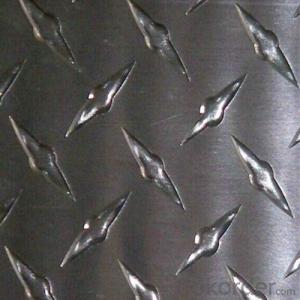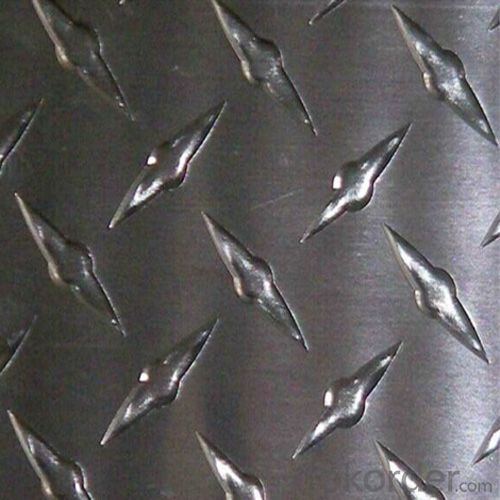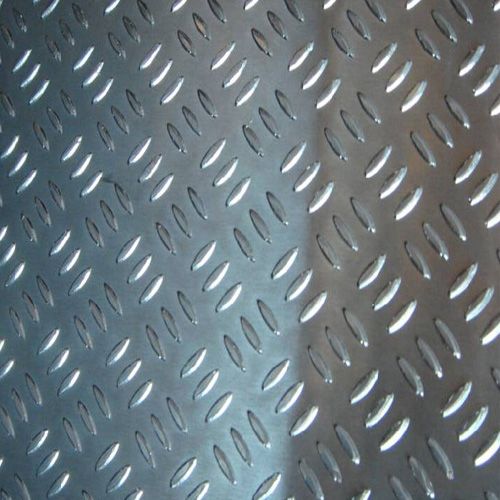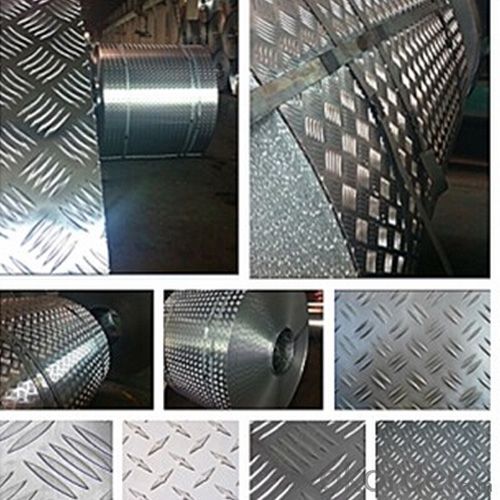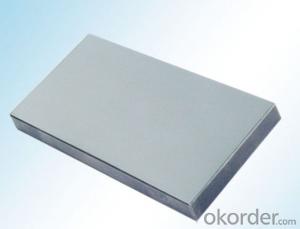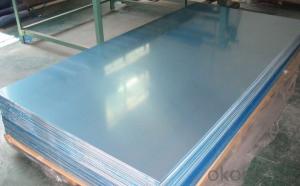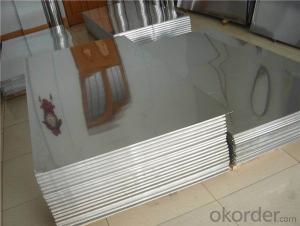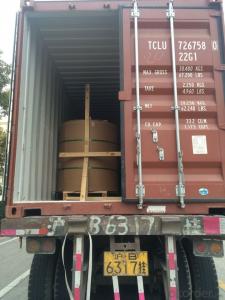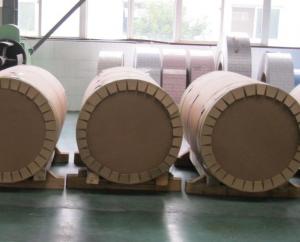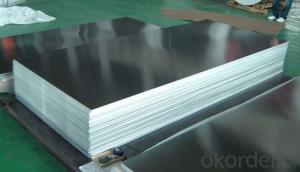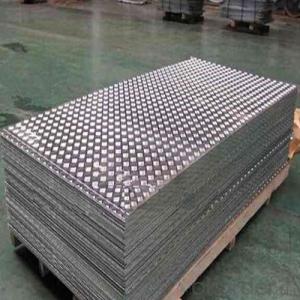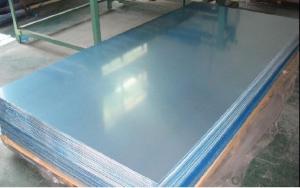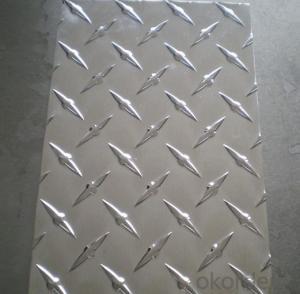Skid-Proof Aluminum Alloy Checker Plate for Fence - Best Price Aluminum Sheets
- Loading Port:
- Shanghai
- Payment Terms:
- TT OR LC
- Min Order Qty:
- 5 m.t.
- Supply Capability:
- 10000 m.t./month
OKorder Service Pledge
OKorder Financial Service
You Might Also Like
Specification
1.Structure of Skid-Proof Aluminum Alloy Checker Plate Description:
They are widely used in construction and decoration, hardware and electric appliances manufacture, automobile manufacture and other industrial and civil purposes, such as electronic capacitor, rice cooker, refrigerator, computer casting, lamp shade, air-conditioner, cosmetics cover and box, air-conditioner radiator, inner container of disinfecting cabinet, ceiling board, automobile motherboard, cover board and top board, etc.
2.Main Features of Skid-Proof Aluminum Alloy Checker Plate :
Good Corrosion Resistance
Good Machinability
High Quality
Competitive Price
3. Skid-Proof Aluminum Alloy Checker Plate Images:
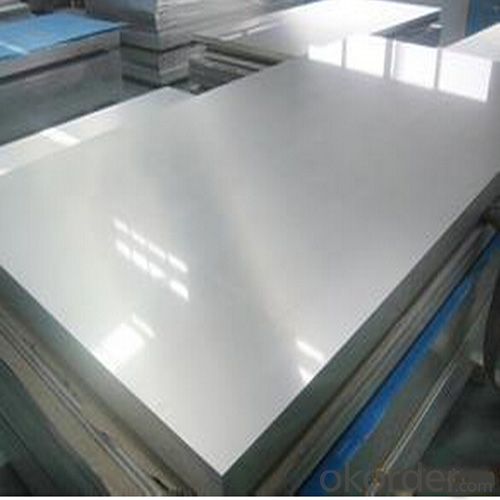
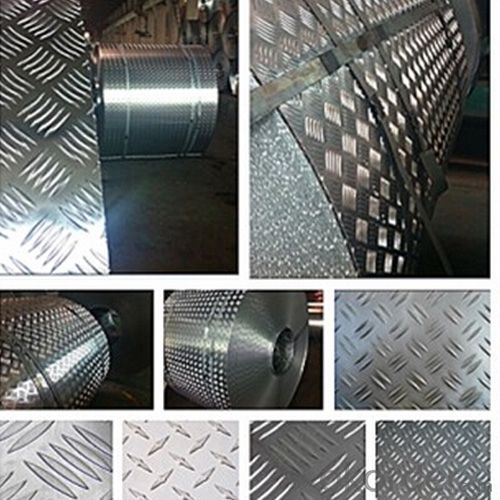
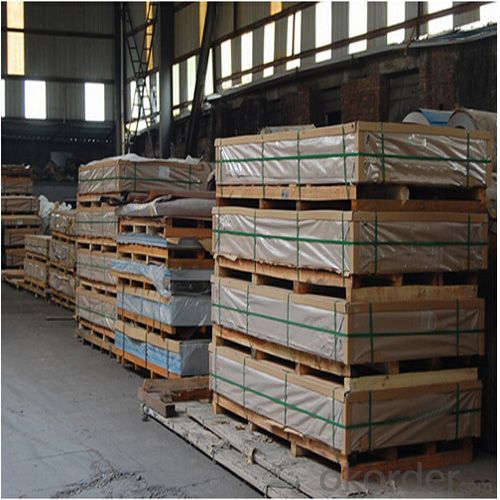
4. Skid-Proof Aluminum Alloy Checker Plate Specification:
| Alloy | Si | Fe | Cu | Mn | Mg | Cr | Ni | Zn | Ti | Other | Al | ||
| Single | Total | ||||||||||||
| 1060 | 0.25 | 0.35 | 0.05 | 0.03 | 0.03 | _ | _ | 0.05 | V:0.05 | 0.03 | 0.03 | _ | 99.6 |
| 1050 | 0.25 | 0.4 | 0.05 | 0.05 | 0.05 | _ | _ | 0.05 | V:0.05 | 0.03 | 0.03 | _ | 99.5 |
| 1100 | Si+Fe:0.95 | 0.05~0.40 | 0.05 | _ | _ | _ | 0.1 | _ | _ | 0.05 | 0.15 | 99 | |
| 1200 | Si+Fe:1.00 | 0.05 | 0.05 | _ | _ | 0.1 | _ | 0.05 | 0.05 | 0.15 | 99 | ||
| 3003 | 0.6 | 0.7 | 0.05~0.20 | 1.0~1.5 | _ | _ | _ | 0.1 | _ | 0.05 | 0.15 | R | |
| 3004 | 0.3 | 0.7 | 0.25 | 1.0~1.5 | 0.8~1.3 | _ | _ | 0.25 | _ | 0.05 | 0.15 | R | |
| 3005 | 0.6 | 0.7 | 0.3 | 1.0~1.5 | 0.20~0.6 | 0.1 | _ | 0.25 | 0.1 | 0.05 | 0.15 | R | |
| 3105 | 0.6 | 0.7 | 0.3 | 0.30~0.8 | 0.20~0.8 | 0.2 | _ | 0.4 | 0.1 | 0.05 | 0.15 | R | |
| 5005 | 0.3 | 0.7 | 0.2 | 0.2 | 0.50~1.1 | 0.1 | _ | 0.25 | _ | _ | 0.05 | 0.15 | R |
| 5052 | 0.25 | 0.4 | 0.1 | 0.1 | 2.2~2.8 | 0.15~0.35 | _ | 0.1 | _ | _ | 0.05 | 0.15 | R |
| 5083 | 0.4 | 0.4 | 0.1 | 0.40~1.0 | 4.0~4.9 | 0.05~0.25 | _ | 0.25 | _ | 0.15 | 0.05 | 0.15 | R |
| 5086 | 0.4 | 0.5 | 0.1 | 0.20~0.7 | 3.5~4.5 | 0.05~0.25 | _ | 0.25 | _ | 0.15 | 0.05 | 0.15 | R |
5.FAQ
Q1.How long have you been in this product?
A1:More than 10 years.
Q2. What's the minium quantity(MOQ)?
A2. 5 Metric tons
Q3. How long is shipping time?
A3. 7 (ready-made products)-25 days(OEM)
Q4. How do you guarantee the quality?
A4. 1. Cooperating and Exchaning experience with sevral quoted aluminum companies
2. Japanese and Swiss production line and skilled works (regular training and testing)
3. more than 10 years production experience.
Q5. Do you have after sale service?
A5. Yes. Any quality problem occurs within one year, pls take photoes,we will be responsible.
- Q: What are the distinctions between standard aluminum windows and those that are custom-made?
- <p>Standard aluminum windows are mass-produced and come in set sizes and styles, offering affordability and quick installation. They may not fit perfectly into unique spaces and may lack customization options. Custom-made aluminum windows, on the other hand, are tailored to specific dimensions and design preferences, ensuring a perfect fit and enhanced aesthetics. They often come with more features and options, such as energy efficiency, security, and unique styling, but are typically more expensive and have a longer lead time for production and installation.</p>
- Q: What is aluminium plate L2-Y2?
- L2Y2 is an industrial pure aluminum sheet:1, L2: China's industrial pure aluminum grades are limited by impurities to prepare, such as L1, L2, L3...... L, is the "aluminum" word Pinyin prefix, followed by the attached order number is bigger, its purity is low. Industrial pure aluminum is generally defined as aluminum with a purity of 99% to 99.9%, and China is designated as 98.8% - 99.7% aluminum.
- Q: The question asks if it is possible to recycle used aluminum foil to create new aluminum sheets.
- <p>Yes, recycled aluminum foil can be used to make new aluminum sheets. The process involves collecting and sorting the foil, which is then cleaned and melted down. The molten aluminum is poured into molds or rolled into sheets, creating new aluminum products. This recycling method is not only environmentally friendly but also economically viable as it saves energy compared to producing aluminum from raw materials.</p>
- Q: What are the different methods of surface protection for outdoor aluminum sheet?
- To ensure the durability and longevity of outdoor aluminum sheets, there are several methods available for surface protection. These methods offer varying advantages and limitations, and the choice should be based on factors such as durability, appearance, cost, and maintenance requirements. One common method is anodizing, which creates a protective oxide layer on the surface. This increases resistance to corrosion, abrasion, and UV rays, while also providing a range of colors and finishes. Another option is powder coating, where a dry powder is applied to the aluminum sheet and baked to create a hard, protective coating. This method offers excellent resistance to weathering, corrosion, and chemicals, and is available in various colors and finishes. Paint coating is another effective method, creating a barrier between the aluminum surface and the environment to prevent corrosion while enhancing aesthetics. It is important to use high-quality paint specifically designed for aluminum to ensure proper adhesion and durability. For those looking to protect the natural appearance of aluminum, clear coating is an option. It provides a layer of protection against corrosion, oxidation, and UV rays and is often applied after anodizing or polishing. Laminating involves adhering a protective film or sheet onto the aluminum surface, offering excellent resistance to scratches, abrasion, and UV rays. This method is commonly used in applications with heavy wear and tear. Chemical conversion coatings, such as chromate conversion coating or phosphating, can be used to improve the corrosion resistance of aluminum sheets. These coatings chemically react with the surface to create a protective layer that inhibits corrosion. When choosing a method of surface protection, it is crucial to consider specific requirements and environmental conditions. Each method has its own advantages and limitations, so careful consideration is needed to ensure the best choice for the aluminum sheet's needs.
- Q: Can aluminum sheets be easily formed into different shapes?
- Aluminum sheets possess the capability to assume diverse forms with ease. Being an exceedingly flexible metal, aluminum can be effortlessly curved, stretched, and shaped without experiencing any cracks or fractures. This property renders aluminum a favored choice across numerous industries, ranging from automotive and aerospace to construction and manufacturing. Utilizing a variety of techniques such as bending, rolling, stamping, and deep drawing, aluminum sheets can be transformed into intricate and intricate designs. Moreover, owing to its lightweight nature, aluminum proves even more manageable during the formation process, requiring less force and energy. Consequently, aluminum sheets exhibit tremendous versatility and adaptability, rendering them exceptionally suitable for the creation of various shapes and structures.
- Q: How do you calculate the weight of an aluminum sheet?
- To determine the weight of an aluminum sheet, one must take into account its dimensions (length, width, and thickness) as well as the density of aluminum. Initially, one should measure the length, width, and thickness of the aluminum sheet in either inches or millimeters. It is crucial to use a consistent unit of measurement throughout the calculation. Subsequently, if necessary, the dimensions should be converted to feet or meters. For instance, if the dimensions are in inches, divide each value by 12 to convert them to feet. To ascertain the volume of the aluminum sheet, multiply the length, width, and thickness together. In case the dimensions are in different units, they must be converted to the same unit before multiplying. Next, consult a reference for the density of aluminum. Aluminum's density is approximately 2.7 grams per cubic centimeter or 2700 kilograms per cubic meter. Convert the volume of the aluminum sheet to the same unit as the density. For example, if the density is in kilograms per cubic meter and the volume is in cubic feet, multiply the volume by 0.0283 to convert it to cubic meters. Lastly, multiply the volume of the aluminum sheet by the density of aluminum to determine the weight of the sheet. The resulting weight will be in grams or kilograms if the density was in grams per cubic centimeter, or in kilograms or metric tons if the density was in kilograms per cubic meter. It is important to note that this calculation assumes a uniform thickness throughout the aluminum sheet. If the sheet has varying thicknesses, one must calculate the weight of each section individually and then sum them to find the total weight.
- Q: Are aluminum sheets suitable for food storage containers?
- Yes, aluminum sheets are suitable for food storage containers. Aluminum is a safe and durable material that is resistant to corrosion, making it ideal for storing and preserving food. It also has excellent heat conduction properties, allowing for even cooking and reheating.
- Q: Can aluminum sheets be laser cut?
- Indeed, it is possible to laser cut aluminum sheets. Laser cutting is widely favored for its remarkable accuracy and efficiency when it comes to cutting aluminum sheets. This cutting technique entails employing a high-powered laser to either melt or vaporize the material, resulting in a precise and neat cut. Due to its high reflectivity, aluminum necessitates a laser with greater power to effectively penetrate through it. Nevertheless, once the appropriate laser parameters are established, laser cutting machines can easily and precisely cut aluminum sheets. This method finds extensive application in industries such as automotive, aerospace, and manufacturing, where aluminum sheets are utilized for various purposes.
- Q: How strong is aluminum per square inch, and at the same time how light is the aluminum per square inch?
- How strong aluminum is, depends on the specific alloy of aluminum, whether it is the aluminum 1000 series, or the 3000 series, or the 6000 series, or other variants. The 6000 series is most common for structural purposes. Do a search on its yield strength and its ultimate tensile strength, to get an idea of how strong your particular variant is. The alloy Aluminum 6061-T6 has a yield strength of 35000 lb/in^2, and an ultimate tensile strength of 42000 lb/in^2. This is for the case of pure tension with a uniform load. The square inches refers to its cross sectional area. The ultimate strength occurs at the point where it will completely rupture. The yield strength occurs at the point, where it still supports the load, but ceases to be reversible after the load is removed. Pure aluminum metal is much weaker than its alloys. It has a yield strength of about 1500 psi, and an ultimate strength of 10000 psi. For structural purposes, you almost always want to stay below the yield strength. How stiff aluminum is, is common among all alloys, as 10000000 psi. That is to say 10 million pounds of tension on an aluminum member with a cross sectional area of 1 inch, would hypothetically cause an increase equal to 1 length, if it were still in-tact and linear-elastic at that amount of stress. It isn't. A more realistic case, would be that 10000 pounds of tension on this member, would cause an 0.1% increase in length. As for how light aluminum is per square inch, that depends upon how long your rod is. A 3 ft rod weighs 3 times as much per square inch as does a 1 ft rod. The weight of a material is measured PER UNIT VOLUME rather than per unit area. Unless you are talking about a standard thickness. Aluminum 6061 alloys have a density of 0.0975 pounds/cubic inch. Pure aluminum has a this density as well, as do most of its alloys.
- Q: Can aluminum sheets be used for insulation purposes?
- Yes, aluminum sheets can be used for insulation purposes. They have a low thermal conductivity and can effectively reflect heat and cold, making them suitable for insulating applications in various industries such as construction, automotive, and packaging.
Send your message to us
Skid-Proof Aluminum Alloy Checker Plate for Fence - Best Price Aluminum Sheets
- Loading Port:
- Shanghai
- Payment Terms:
- TT OR LC
- Min Order Qty:
- 5 m.t.
- Supply Capability:
- 10000 m.t./month
OKorder Service Pledge
OKorder Financial Service
Similar products
Hot products
Hot Searches
Related keywords
